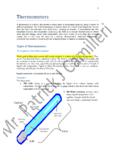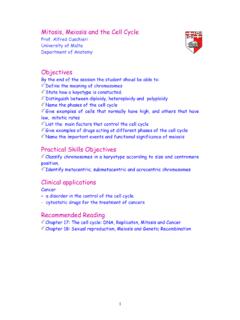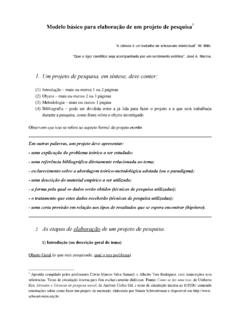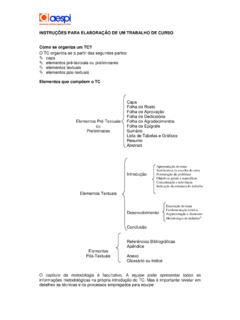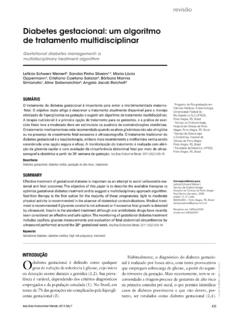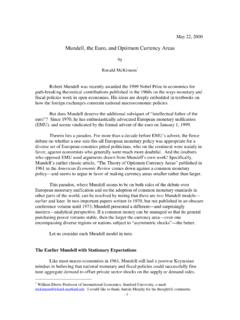Transcription of Metric Spaces - Search - University of Malta
1 1 Distance J Muscat 1. Metric Spaces Joseph Muscat 2003. (Last revised May 2009). (A revised and expanded version of these notes are now published by Springer.). 1 Distance A Metric space can be thought of as a very basic space having a geometry, with only a few axioms. Metric Spaces are generalizations of the real line, in which some of the theorems that hold for R remain valid. Some of the main results in real analysis are (i) Cauchy sequences converge, (ii) for continuous functions f (limn xn ) = limn f (xn ), (iii) continuous real functions are bounded on intervals of type [a, b] and satisfy the intermediate value theorem, etc. At first sight, it is difficult to generalize these theorems, say to sequences and continuous functions of several variables such as f (x, y). That is the aim of this abstract course: to show how these theorems apply in a much more general setting than R.
2 The fundamental ingredient that is needed is that of a distance or Metric . This is not enough, however, to get the best results and we need to specify later that the distance be of a nice type, called a complete Metric . In what follows the Metric space X will denote an abstract set, not neces- sarily R or Rn , although these are of the most immediate interest. When we refer to points we do not necessarily refer to geometrical points, although this is how most of us visualize them. They may in fact be sequences, func- tions, images, sounds, signals, etc. Definition A distance or Metric on a Metric space X is a function d : X 2 7 R+. (x, y) 7 d(x, y). with the properties (i) d(x, y) = 0 x = y (ii) d(y, x) = d(x, y). (iii) d(x, y) 6 d(x, z) + d(y, z). for all x, y, z X. 1 Distance J Muscat 2.
3 Example On N, Q, R, C, and RN , one can take the standard Euclidean distance d(x, y) := |x y|. Check that the three axioms for a distance are satisfied n qP|a + b| 6 |a| + |b|). Note that for R , the Euclidean (make use of the fact that i=n 2. distance is d(x, y) := i=1 |xi yi | . One can define distances on other more general Spaces , the space of continuous functions f (x) with x [0, 1] has a distance defined by d(f, g) :=. maxx [0,1] |f (x) g(x)|. The space of shapes (roughly speaking, subsets of R2 having an area) have a Metric d(A, B) := area of (A B rA B). In all these cases we get an idea of which elements are close together by looking at their distance. Exercises 1. Show that if x1 , .. , xn are n points, then d(x1 , xn ) 6 d(x1 , x2 ) + .. + d(xn 1 , xn ). 2. Verify that the Metric defined on R2 does indeed satisfy the Metric axioms.
4 3. Show that if d is a Metric , then so are the maps D1 (x, y) := 2d(x, y). d(x,y). and D2 (x, y) := 1+d(x,y) , but that d(x, y)2 need not be a Metric . Hence a Metric space can have several metrics . 4. Show that if X, Y are Metric Spaces with distances dX and dY , then X Y is also a Metric space with distance . x x D( 1 , 2 ) := dX (x1 , x2 ) + dY (y1 , y2 ). y1 y2. (Note that for R2 , this Metric is not the Euclidean one.). 5. Show further that . x1 , x2 ) := max(dX (x1 , x2 ), dY (y1 , y2 )). D(. y1 y2. is also a Metric for X Y . 6. Prove that the function d(m, n) := |1/m 1/n|, on the natural numbers, is a Metric . Balls J Muscat 3. 7. Show that in fact the axioms (i) and (iii) imply both d(x, y) > 0 and axiom (ii). 8. Show that d(x, y) > |d(x, z) d(y, z)|. 9. Consider the set X of bytes, , sequences of 0s and 1s of length 8.
5 The Hamming distance between two bytes is defined as the number of places where their bits differ. Show that this is a distance on X. Balls Definition An (open) ball is the set Br (a) := { x X : d(x, a) < r }. where a X is its center and r > 0 its radius. Note: The ball is the surroundings of the point a. One can consider . and X to be balls with r = 0 and r = respectively, but this is unusual. Although we call it a ball, one must remove any preconceptions of it being round etc. In R, every ball Br (a) = { x R : |x a| < r } = (a r, a + r) is just an open interval. In particular, B1/2 (a) = (a 1/2, a + 1/2). Conversely, any open interval of the type (a, b) is a ball in R, with center (a + b)/2 and radius (b a)/2. In R2 , the ball Br (a) is the disk with center a and radius r without the circular perimeter.
6 In N, the ball B1/2 (m) = { m }, and B2 (m) = { m 1, m, m + 1 }. Definition A point x of a set A is called an interior point of A when > 0 B (x) A. A point x (not in A) is an exterior point of A when > 0 B (x) X rA. All other points of X are called boundary points. A point x of A is called an isolated point when there is a ball B (x) which contains no points of A other than x itself. Balls J Muscat 4. Definition A set A is open in X when all its points are interior points. Note: An interior point of A can be surrounded completely by a ball inside A ; open sets do not contain their boundary . We also say that A is a neighborhood of a when a is an interior point of A. The empty set is open by default, because it does not contain any points. The whole space X is also open because any ball about any point of X is a subset of X.
7 Example Show that (a, b) is open in R, but that [a, b] and { a } are not. Theorem A. Balls are open sets in X. Proof Let x Br (a) be any point in the given ball. This means that d(x, a) < r. Let := r d(x, a) which is positive. Then B (x) Br (a) since for any y B (x), d(y, a) 6 d(y, x) + d(x, a) < + d(x, a) = r. Therefore y Br (a).. Open sets, however, need not be balls. Note that we need to specify that A is open in X. For example we have seen that { m } is open in N (since it is a ball in N) but not open in R (see previous example). Theorem B. A set is open it is the union of balls. Balls J Muscat 5. Proof Let A be an open set. Then x A > 0 x B (x) A. which implies that [ [. A= {x} B (x) A. x A x A. S. Hence A = B (x), a union of balls. x A. S. Conversely, let A = i Bri (ai ) be a union of balls, and let x be any point in A.]]
8 Then x is in at least one of these balls, say, Br (a). But balls are open and hence x B (x) Br (a) A. A is therefore open.. One can study open sets without reference to balls or metrics in the subject of topology. The basic properties of open sets are: Theorem C. Any union of open sets is open. Any finite intersection of open sets is open. S S. Proof Consider i Ai where Ai are all open. Given any x i Ai , it must lie in at least one of these sets Ai which is open. Therefore [. x Br (x) Ai Ai i showing that the union is open. For the second part it is enough to consider the intersection of two open sets A B (the rest can be done by induction). Let x A B. Then x A. and x B, both sets being open. Therefore there are open balls Br1 (x) A. and Br2 (x) B. Pick the smaller of these two balls, say the one with radius r1.]
9 Then, x Br1 (x) Br1 (x) Br2 (x) A B.. Balls J Muscat 6. Example In R the intersection of two open intervals is either empty or else another open interval, both of which are open. Any collection of open intervals is open. Note that an infinite intersection of open sets need not be open. For example, in R, consider the open intervals ( 1/2n , 1/2n ) which are nested one inside another. Their intersection is just the set { 0 } (prove this!) which is not open in R. Theorem D. Distinct points in X can be separated by disjoint open balls. x 6= y r > 0 Br (x) Br (y) = . Proof If x 6= y then d(x, y) > 0. Let r := d(x, y)/2. Then Br (x) . Br (y) = since otherwise, z Br (x) Br (y) d(x, z) < r and d(y, z) < r d(x, y) 6 d(x, z) + d(y, z) < 2r = d(x, y). which is a contradiction.. Exercises 1. If r1 < r2 , show that Br1 (x) Br2 (x).
10 2. Show that in R, the sets (a, ) and ( , a) are open sets. 3. Show that in R2 , (i) the half-plane S = { (x, y) R2 : y > 0 } and (ii). the rectangles R = { (x, y) R2 : a < x < b, c < y < d } are open sets. 4. Show that the interval (a, b) on the x-axis, is open in R but not open in R2 . Balls J Muscat 7. 5. Find an example in R2 in which the infinite intersection of open sets is not open. 6. Show that for any Metric space X, the set X r{ x } is open in X. 7. Prove properly by induction, that the finite intersection of open sets is open. 8. Show that if { x } are open sets in X for all points x X, then all subsets of X are also open in X. In particular, all subsets of N are open in N. 9. Given any set X, let (. 0 x=y d(x, y) = . 6 y 1 x=. Show that d is a Metric (it is called the discrete Metric ), for which the open balls are just the sets { x } and X.)
